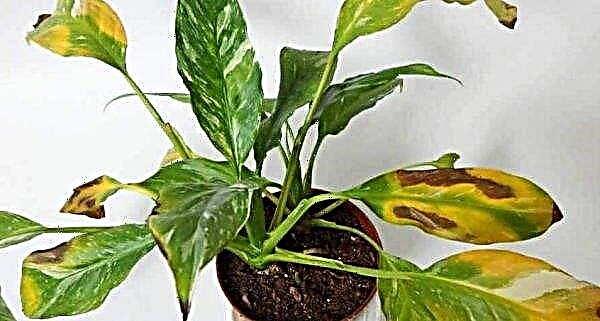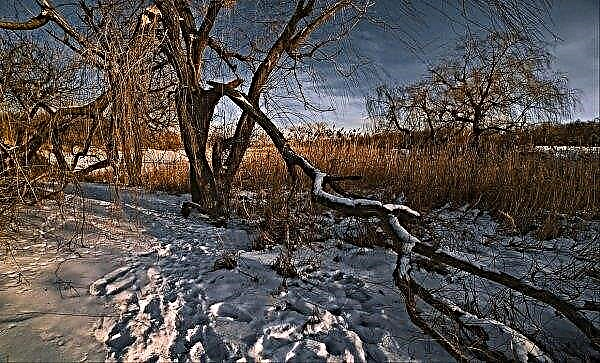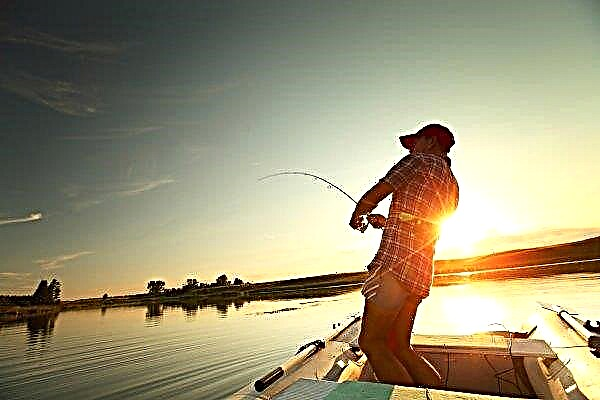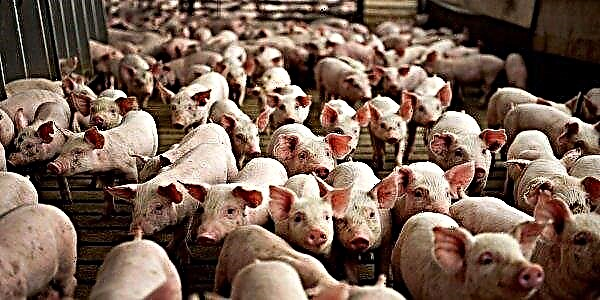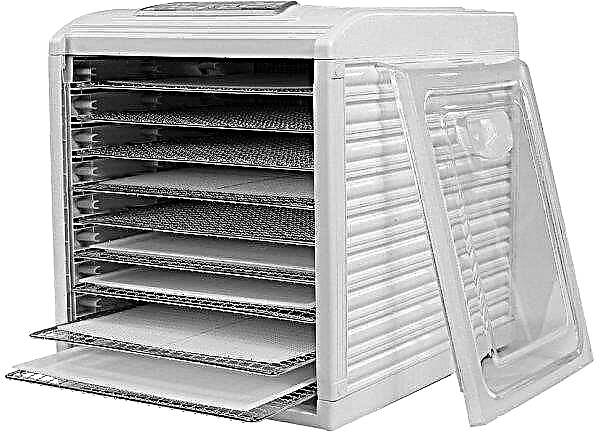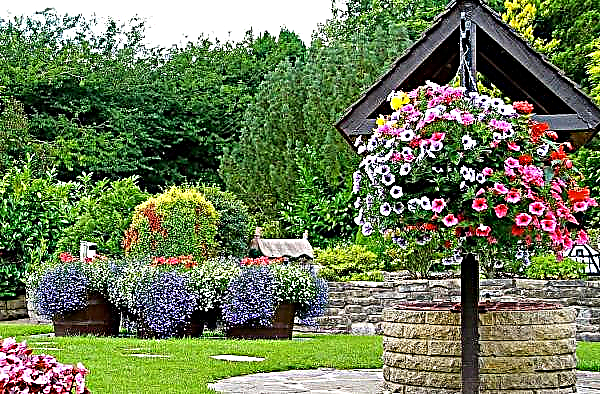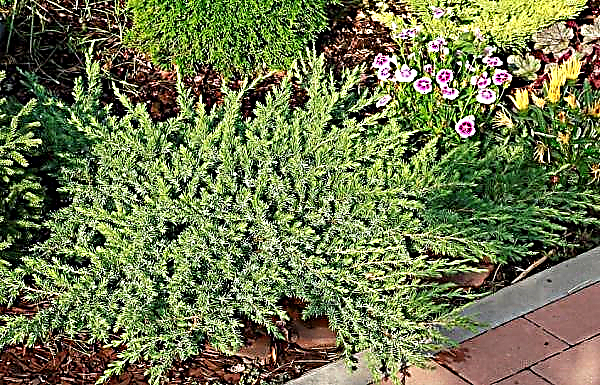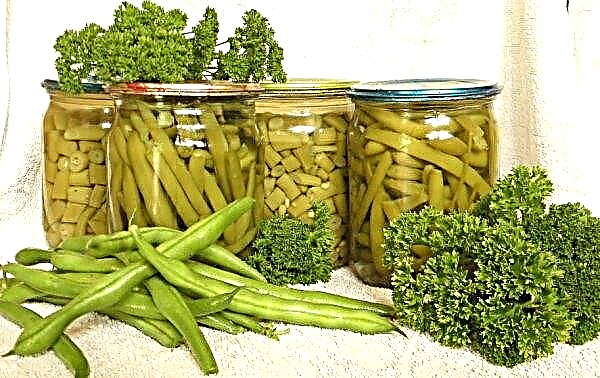Evergreen trees are often planted in the garden, as they do not lose decorativeness at any time of the year. They are not capricious, but require fertile, well-permeable soil and periodic pruning. The article is devoted to Fir Compact, here will be given recommendations for planting and caring for the plant, as well as a description and characteristics of the variety.
Botanical Description
Compact dwarf fir (Abies lasiocarpa Compacta), or mountain spruce, belongs to the Pinaceae family. It was introduced to Europe at the beginning of the XXI century from North America, where it grows in natural conditions in the high mountains of Arizona, New Mexico and Colorado. This subalpine coniferous species is also known as Arizona, in connection with the area where these trees were first discovered.
The variety is characterized by slow growth, regular crown and a very beautiful, silver color of needle leaves. In older specimens, as a result of growth inhibition, the apex assumes a rounded or flat shape. The dwarf Compact is ideal for planting in small garden plots.

This is a low, slowly growing, conical tree, after 30 years of cultivation, reaching only three meters in height. It has a clear outline, after reaching 15 years, the crown width in the lower part often exceeds 2.5–3 m. A beautiful straight trunk is covered with a characteristic cork white-gray bark, which is difficult to see due to the dense arrangement of shoots.
The branches themselves are quite short, stiff, pubescent with silver needles. The plant is somewhat similar to prickly spruce, but, in contrast to it, fir needles are soft and pleasant to the touch. After shaping or sanitary trimming, an intense, balsamic, pleasant aroma appears.
Important! Fir oil has an expectorant, diuretic and antiseptic effect on people, so it is used for inhalation in the treatment of respiratory diseases.
The variety grows well in fertile, moist soils with an acidic pH. He also likes to be located in places with high humidity, near water bodies. To maintain a bright blue tint of needles, they are best planted in sunny places. Abies Compacta is completely frost-resistant, although the youngest shoots that appear on the south side of the tree are sometimes damaged by late spring frosts. Mountain spruce respond well to mulching the surface with pine bark, previously composted.

Landing
Subalpine fir loves well-cultivated land, loose and fertile. In nature, the tree grows on sandy loamy soils. The culture does not tolerate drought, heat and sudden fluctuations in temperature. It is very sensitive to air pollution. Compacta has a vertically developed root system, and a deep hole is required for planting. The variety likes its location in the sun, but at a young age normally tolerates the shadow, although it often loses its lower branches. In this case, it is necessary to trim the dead parts.
Did you know? Owners of horses need to carefully ensure that their pets do not eat around the branches of fir. The needles and resin of this culture secrete pinene and limonene - essential oils that irritate the mucous membrane of the gastrointestinal tract of animals, and also cause serious damage to the kidneys.
Fir trees planted in spring and summer are more likely to dry out and need regular watering. The recommended planting date for conifers is in late August or October. Plants grown in pots or containers can be moved to a permanent place in any part of the warm season, as this is done by a simple method of transshipment, without damaging the root system. If the work is carried out in early spring, then the gardener should make sure that the ground has already thawed.
Compact fir planting:
- It is necessary to clean the place of the future location of the tree from perennial weeds (morning glory, birch, horsetail, wheatgrass). If the method of chemical soil treatment is chosen, then the event should be held approximately 4 weeks before the intended date of planting. You can use herbicides ("Ziemovit Agrosar 360 SL", "Hurricane Forte", "Agritox", "Zenkor") to help fight single and dicotyledonous weeds. Weeding can be carried out mechanically, using ordinary garden pitchforks.
- At the future location of the fir you need to check the type of soil. If it is not suitable, you can improve the structure of the substrate or enrich it with organic matter.
- Next, with the help of a shovel, a landing pit is made that is suitable in size to the root ball of the plant. Typically, the diameter of the hole in the ground is about 1.5 times the volume of the roots. The soil at the base and walls of the soil recess should be slightly loosened with the tip of the tool. This will contribute to the growth of the underground part of the Compact in breadth and inland.
- If the earth is dense, loamy and impermeable, you can add coarse sand or expanded clay to the substrate at the planting site. The rest of the pit is filled with surface soil mixed with acidic garden peat. If the soil is sandy, it is mixed with clay or peat.
- To improve the rooting of a seedling, a plant bought in a pot is recommended to soak before planting for 10-30 minutes in water. The substrate absorbs moisture well, and this facilitates the removal of the soil ball from the container. Before moving the fir, lightly tap the bottom of the tank so that the soil exfoliates from the walls and is easy to remove. If it is noticed that the roots are tightly sealed and intertwined, they need to be trimmed with a knife or garden shears.
- It should not be forgotten that a tree grown in a container is planted below the height of the pot. The root of the neck (it can be seen by the darker mark on the trunk at the point where it was in contact with the soil in the pot) cannot be covered with soil. Otherwise, the growth of fir will stop.
- The tree should be located vertically, so it is recommended to plant it with the help of two people. The necessary top dressing, for example, finished mineral fertilizers for conifers, is added to the soil recess. You can prepare a mixture of chernozem and ground peat (in a ratio of 1: 1), it is desirable that the pH of the resulting substrate has a value below 6, which will significantly improve the conditions for the development of fir.
- The bottom of the pit is filled with part of the prepared soil mixture. A sapling is placed in a recess, its roots are covered with the remaining nutrient soil, and it is poured flush with the surface of ordinary garden soil. The landing site is well compacted and a small “bowl” is formed, whose diameter is twice the size of the trunk circle.
- The first plentiful watering is carried out immediately after moving the plant, especially in spring or summer. If the gardener sees that the seedling has dry or damaged shoots, then after planting, a sanitary haircut of the problem areas should be carried out.

Fir Care
To dwarf fir really decorated the garden, the owner should carefully care for it. The plant requires not only proper planting, but also constant attention in the future: watering, fertilizing, loosening and mulching the soil, pruning branches, protection from sunburn in the winter. It is also necessary to carry out preventive and medicinal treatment of the crown against viral and fungal diseases. It is important to examine the needles for the presence of pests and, if necessary, use special preparations to combat them.
Did you know? Fir is a well-known long-lived among the plant world, a tree can exist from 300 to 700 years, depending on the species and climatic conditions.
Watering and feeding
The frequency and abundance of irrigation depends on many factors, for example, the season, current weather, soil conditions and plant needs. The humidity of the substrate should be controlled and regulated by irrigation.

Watering Rules:
- Young conifers require more water, so they should be irrigated at least 3 times a week for the first 14–20 days after planting. The best time is evening or morning, but you should not carry out such work during the day, especially in the heat.
- Evergreen trees should also be watered in late autumn or even winter, especially if there is no snow and frost. The same should be done at the beginning of spring, since at this time the plantations are subject to physiological drought. Thanks to good hydration, the chances of a successful wintering are significantly increased.
- Regular irrigation is recommended on light and sandy soils, especially with intensive growth (spring, summer) and in hot weather. From 1 to 4 years from the time of planting: in rainy weather, watering is carried out every 7-15 days, in dry periods - every 5-7 days. Depending on the size of the tree, water is served in large portions, 15–40 l at a time.
- In no case should you water the conifers often with a small amount of water, because only the topsoil is wetted. Such irregular irrigation will lead to horizontal growth of roots, which will spread directly below the surface of the soil, which will increase their susceptibility to drought.
- It is important not to water directly at the trunk, because the active roots go far beyond it. 3-4 years after planting, when the seedling takes root, water is supplied much less frequently, approximately every 7-10 days during periods when there is no rain, and every 10-21 days in the event of rainy weather. In the case of irrigation of conifers grown in containers, it is recommended to use about 5-20 liters per fir, depending on its size.
It is recommended to fertilize the plant during planting or 4-6 weeks after it. If the seedling was moved in the fall, top dressing should not be carried out until spring.
Important! For watering plants, it is recommended to install a drip irrigation system. It will allow you to keep the basal layer of soil moist and timely deliver medicines and preventive drugs.
Fertilizer recommendations:
- Only planted fir need slow-release feeding, for example, “Ziemovit Long-acting fertilizer for conifers”. Depending on the size of the plant, 10-30 g of the nutrient mixture are mixed with 10 l of soil, which cover the surface of the trunk circle.
- It is necessary to periodically make preparations to improve the intensity of the color of the needles, and to prevent the occurrence of fungal diseases. These products can be purchased at garden stores. Usually they are applied under the root in the form of solutions, twice from April to June and once in the beginning of autumn, or as a spray on leaves 2-3 times during the warm season (10 g / 1 liter of water), starting in April. The gardener should not forget about the 10-day intervals between the procedures.
- 2-3 years after planting, developing mountain spruces need spring top dressing, they are carried out once, in late March or early April. Long-acting fertilizer “Ziemovit for coniferous fertilizer” can be used. Depending on the age of the fir, the drug is distributed in a dose of 100 to 200 g / 1 m² above ground, over the entire diameter of the trunk volume. Further, it is recommended to water the tree abundantly with clean water so that the nutrients that have fallen on the ground dissolve and leak to the roots.
- By July or mid-August, nitrogen fertilizer should be applied, this top dressing will be the last in the current season, since later it can cause stimulation of fir growth. This is very undesirable, because the young mountain spruce does not have time to prepare for the winter and can freeze.

Loosening and mulching
The space around the fir is covered with crushed bark. For this, the best waste from pine, pre-composted, without debris and branches, the individual fragments should have a fraction of not more than 20–80 mm. The thickness of the mulching layer should not exceed 5–8 cm. Thus, the coniferous plant will be able to maintain an appropriate pH level. In the basal zone, you can lay a layer of decorative stones. Any of these mulching methods will protect the young tree from drying out, overgrowth of weeds and freezing of the soil.
As a top dressing in the near-stem circle, it is recommended to lay out compost at least three years old. Fertilizer should be scattered so that a distance of at least 2.5–5 cm is observed from organic to the base of the trunk. Serve food no more than once every 3-5 years.

Pruning
On young trees, you can correct improper growth or curvature by tying them to support stakes in several places. The damaged tip should be cut off and replaced with one of the lateral processes. It will serve in the future as the peak of a mountain spruce, which the gardener will be guided by by cutting the side branches. If competitive shoots appear there, they are cut off so as not to spoil the clear wide-conical outlines.
Video: Trimming Fir
Winter preparations
Since fir is a very frost-resistant tree, it does not need additional insulation so as not to suffer during the winter cold. It will be enough for the garden owner to shake the branches slightly after heavy snowfalls so that they do not break under heavy load. At the end of winter, the activity of the sun increases significantly, and its rays can cause burns of coniferous evergreens.
Did you know? Modern pharmacology uses fir oil as a raw material for the manufacture of synthetic camphor, used to facilitate inflammatory processes in the body and treat all kinds of infectious diseases.
The leaves on the affected branches will turn brown and fall over time, which will significantly reduce the decorativeness of dwarf fir. To prevent this from happening, the tree is wrapped with paper or agricultural fiber is thrown onto the crown. Since both materials pass air well, wrapping can be done in late November or early December. It will not be too late to establish protection immediately before the onset of a dangerous period, in the second half of February. Shelter from the sun is removed at the end of March, when the average daily positive air temperature is established.

Possible diseases and pests
Pests of Abies lasiocarpa Compacta cause yellowness and fall of fir needles, which makes the trees look unsightly, significantly losing their beauty.
The most common harmful insects:
- Fir aphids- eats on the underside of needles, sucking the contents of plant cells. As a result of damage to the needles, large yellow spots appear, with time they fall, and the branches turn brown and die. Larvae hibernate on leaves, in May they begin to feed, resuming their activity, and lay eggs, from which new individuals hatch in two weeks. In July, the parasites no longer eat, but settle for the winter. Some turn into winged forms and migrate to other trees. To combat them, it is recommended for a long period to apply aphids, for example, “Decis Garden 015 EW”. It should also be carried out in early spring preventive spraying with oil preparations "Promanal 60 EC" or "Emulpar 940 EC". These agents cover insects during the wintering stage with a film that makes breathing difficult, as a result of which they die.

- Pine spider mite - lays eggs that winter in the fir bark, in late April, larvae hatch from them, migrating further to needles. There they eat until they reach adulthood. In summer, a light web appears on the branches, which is a sure sign of a parasite populating a tree. It is also a protective barrier through which plant protection products do not penetrate well. It is difficult to deal with a spider mite, it is much more effective to take appropriate preventive measures against it. As in the case of aphids, it is important in the early spring to treat pests of mountain spruce with oil preparations.These chemicals will destroy the wintering eggs of the pine spider mite and protect the fir from infection in the summer. If spraying was not carried out in early spring, the gardener should inspect the tree in May and conduct a quick test. A white sheet is laid out on the ground and the branches are shaken sharply, after which they examine the showered insects. If a parasite is found, then it is necessary to spray the tree crown with Karate Zeon 050 SC or Ortus 05 SC.
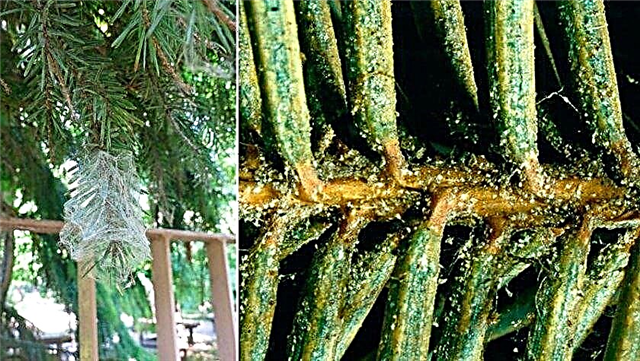
Like other conifers, firs are susceptible to fungal and bacterial diseases. In order to prevent and treat, gardeners treat the stem and crown with special preparations, spraying them in the form of fine water dust from a pump sprayer.
Breeding
Male flowers are formed on the underside of the branches at the ends of the needles and have the shape of rollers. Light, in relation to the main color, cone-shaped female inflorescences are grouped on top of a tree.
Important! Since mountain spruces are quite expensive, and the price of a 2-3-year-old seedling in a pot can reach 1000 rubles, and the cost of a small seedling with an open root system is usually several hundred rubles, a gardener should grow them independently. To do this, it is enough to sow seeds from the cones of the desired variety in the soil, and after seedlings, care for the seedlings, as for ordinary seedlings.
On elongated shoots grow soft flat needles, up to 3 cm long. Outside, they are shiny, dark blue, the lower part is decorated with two silver stripes. On the upper and well-lit lateral shoots, the needles are less flattened and directed upwards, while on the shaded branches they are perpendicular to the axis of the shoot. Compacta blooms in April or May, depending on the region of cultivation, after which green testes (buds) form on the tree.

At the end of September they turn brown, which indicates maturity, and soon, while still on the branches, disintegrate together with the seeds into separate scales. “Wings” are attached to the seeds of the lasiokarp fir, due to which the culture is dispersed over a considerable distance (using the wind).
Most often, fir is propagated by sowing seeds collected from cones from August to October. Sowing seeds is carried out in the spring, from about mid-April to the end of May.
The use of wood in landscape design
Compact fir, of course, belongs to the most beautiful dwarf evergreens with blue needles. Ideal for growing near buildings or in rockeries, as well as for planting alone or in groups. Trees look especially impressive in spring when they produce new shoots. In winter, especially on New Year's and Christmas, they are decorated with multi-colored garlands.

Once he has planted Compacta dwarf fir in his garden, the owner of the estate will be able to admire the elegant gray-blue needles throughout his life. The plant does not require too much attention, moderate care and protection from pests will be enough for it.




